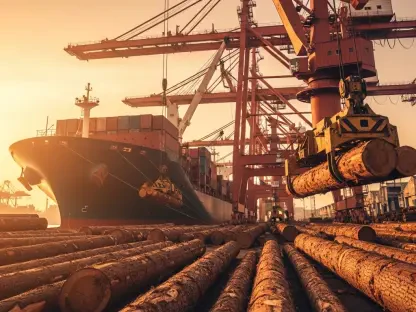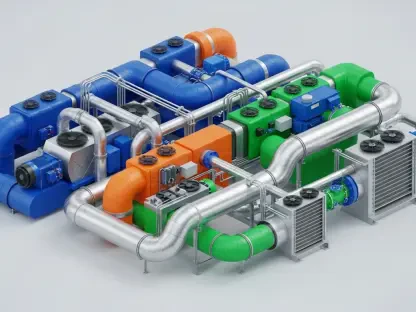The steel industry in Canada stands at a critical juncture, with pioneering efforts to produce greener, low-emission steel clashing against a backdrop of severe market challenges and unpredictable future prospects. Companies like Algoma Steel Inc. have taken bold steps by integrating electric arc furnaces into their operations, aiming to significantly cut carbon emissions and align with global sustainability goals. However, this transition unfolds in a turbulent economic landscape marked by U.S. tariffs, global oversupply, and hesitancy in demand for eco-friendly steel products. These factors cast a shadow over the financial viability of such initiatives, raising questions about whether the market is ready to embrace sustainable steel on a large scale. This article delves into the technological advancements driving this shift, the economic and trade barriers complicating progress, and the policy dilemmas that could shape the industry’s path forward, offering a comprehensive look at a transformative yet uncertain moment for Canadian steel production.
Pioneering Technology for a Sustainable Future
The drive toward sustainability in Canada’s steel sector has gained momentum with Algoma Steel leading the charge through innovative technology. The company recently introduced its low-emission steel product, branded as “Volta,” utilizing electric arc furnaces—a method dating back a century but now adapted for cleaner production. By relying on scrap metal and low-emission iron feed, this approach markedly reduces the environmental footprint of steel manufacturing. According to the International Energy Agency, the steel industry contributes roughly 8% of global carbon emissions, making such advancements crucial for meeting international climate targets. Algoma’s efforts signal a broader industry trend to repurpose existing technologies for ecological benefits, positioning the company as a potential leader in a market increasingly focused on sustainability, even as it navigates significant external pressures that threaten to undermine these environmental gains.
Beyond the technological leap, the significance of Algoma’s innovation lies in its potential to reshape market perceptions and set a precedent for others in the sector. The branding of “Volta” is not merely a product name but a statement of intent to appeal to environmentally conscious buyers, particularly in industries under pressure to reduce their carbon footprints. This strategic move could carve out a niche for Canadian producers in a competitive global landscape, where differentiation is key to survival. However, the success of such initiatives hinges on more than just technological prowess; it requires a receptive market willing to prioritize sustainability over cost. As Algoma pushes forward with this cleaner production method, the challenge remains whether this pioneering spirit can withstand the economic headwinds and trade disruptions that loom large over the industry, testing the resilience of green steel ambitions in Canada.
Economic Barriers and Market Reluctance
Despite the promise of greener steel, the economic realities paint a less optimistic picture for Canadian producers. Experts, including Chris Bataille from Columbia University, express skepticism about the readiness of the North American market to embrace eco-friendly steel, especially amid recent policy shifts in the U.S. that have dampened enthusiasm for cleaner industrial practices. The financial returns on investments in sustainable production remain uncertain, as the upfront costs of transitioning to low-emission methods are substantial. While the environmental benefits are undeniable, the question of whether these initiatives can achieve profitability without widespread market support looms large. This hesitation is evident across various sectors, where the cost of green steel often outweighs the perceived value, creating a significant hurdle for producers aiming to balance sustainability with economic viability.
Adding to these concerns is the stark contrast in demand across different industries and regions, which further complicates the economic outlook. In Europe, some automakers are prepared to pay up to a 40% premium for green steel to bolster their environmental credentials, viewing it as a marketing advantage. However, other key sectors like construction remain resistant to absorbing these additional costs, prioritizing budget constraints over sustainability goals. This reluctance limits the market for premium-priced green steel, confining demand to niche segments and leaving Canadian producers struggling to justify the high capital investments required for green technologies. Until broader acceptance of higher costs emerges, or until production expenses decrease through innovation or scale, the path to financial sustainability for green steel initiatives in Canada will remain fraught with challenges, testing the industry’s resolve to push forward.
Trade Disruptions and Global Pressures
Trade barriers present a formidable obstacle to the growth of Canada’s green steel sector, with U.S. tariffs emerging as a significant threat to domestic producers. Algoma Steel’s CEO, Michael Garcia, has voiced doubts about the feasibility of expanding into international markets, even those with potential like Europe, due to these restrictive trade policies. Such tariffs not only limit export opportunities but also exacerbate the competitive disadvantage faced by Canadian firms already grappling with high production costs for sustainable steel. Trade expert Tommaso Ferretti points out that while structural demand for steel exists in certain regions, the instability caused by ongoing tariff disputes undermines long-term planning. This environment of uncertainty stifles the ability of companies to confidently invest in green initiatives, as the risk of restricted market access looms large over strategic decisions.
Compounding the issue of trade barriers is the persistent problem of global steel oversupply, which continues to depress prices worldwide. With countries like China contributing to an excess of steel in the market, the resulting price drops make it increasingly difficult for Canadian producers to offset the substantial costs associated with transitioning to greener methods. This oversupply dynamic creates a vicious cycle, where low prices discourage investment in sustainable technologies, even as environmental imperatives demand such shifts. For companies like Algoma, the challenge is not just to innovate but to do so in a market that offers little financial incentive for taking on the added expense of eco-friendly production. As trade disruptions and global oversupply persist, the economic rationale for green steel in Canada faces intense scrutiny, pushing the industry to seek solutions that can reconcile these conflicting pressures.
Government Role and Policy Dilemmas
Government support has been a critical factor in advancing green steel projects in Canada, providing a financial cushion for ambitious sustainability efforts. Significant funding has been allocated to key players, with Algoma Steel receiving $420 million for its $880 million project and ArcelorMittal securing $900 million for a $1.8 billion initiative in Hamilton, Ontario. These investments aim to offset the steep capital costs of adopting cleaner technologies, signaling a commitment to reducing the steel sector’s environmental impact. However, the effectiveness of this support is tempered by inconsistencies in policy frameworks, such as fluctuating carbon pricing, which create uncertainty for long-term planning. Without stable and predictable regulations, companies struggle to commit fully to transformative projects, fearing that the ground could shift beneath their investments at any moment.
Moreover, the high costs of cutting-edge processes, such as hydrogen-based iron ore reduction, continue to hinder progress, even with government backing. ArcelorMittal’s project in Hamilton remains in the engineering phase, with no clear timeline for completion, reflecting broader industry caution. Similar initiatives in other regions have been abandoned due to prohibitive energy costs and insufficient customer willingness to pay premiums for green steel. This pattern of stalled or canceled projects underscores the limitations of financial support in the absence of cohesive policy measures that address both cost and demand challenges. For Canada’s green steel ambitions to succeed, a more robust framework that ensures policy consistency and incentivizes market uptake is essential. Until such measures are in place, the industry will grapple with a gap between governmental intent and practical outcomes, slowing the pace of sustainable transformation.
Demand Disparities Across Regions
Regional differences in demand for green steel highlight a fragmented market landscape that poses unique challenges for Canadian producers. In Europe, there is a glimmer of hope as automakers show willingness to invest in eco-friendly steel, often paying substantial premiums to enhance their sustainability profiles. This demand, though limited to specific industries, offers a potential export avenue for Canadian firms seeking to capitalize on greener credentials. However, the contrast with North America is stark, where policy reversals in the U.S. and limited market enthusiasm dampen prospects for widespread adoption. Such disparities create an uneven playing field, where the financial case for green steel varies dramatically by region, complicating strategic decisions for companies aiming to scale up sustainable production while maintaining profitability.
This regional imbalance also underscores a broader market reluctance that extends beyond geography to specific sectors. While European automakers represent a niche but promising demand base, other industries like construction remain largely indifferent to the higher costs of green steel, prioritizing affordability over environmental benefits. For Canadian producers, this means that even in regions with some demand, the overall market pull is insufficient to drive large-scale transitions. The challenge lies in expanding this demand beyond narrow segments, either through targeted incentives or by reducing production costs to make green steel competitive with traditional alternatives. Until a more uniform market acceptance emerges, Canadian firms face the daunting task of navigating these disparities, balancing limited opportunities with the urgent need to reduce emissions in line with global climate goals.
Industry-Wide Caution and Future Pathways
Across the steel industry, a cautious approach to sustainability prevails, as evidenced by stalled projects and widespread hesitancy to fully embrace green technologies. ArcelorMittal’s initiative in Hamilton remains in limbo, mirroring setbacks in other regions where similar projects have been shelved due to high operational costs and policy uncertainties. In the U.S. and Germany, cancellations of green steel conversions highlight the global nature of these challenges, driven by factors like expensive energy and a lack of customer buy-in for premium-priced products. This pattern of caution reflects a deeper tension within the industry: the urgent need to cut emissions clashes with economic realities that make such transitions risky. As global oversupply continues to squeeze profit margins, the appetite for costly innovation diminishes, leaving the sector at a crossroads where ambition often outpaces feasibility.
Looking ahead, the industry’s path forward may lie in innovative strategies and stronger collaboration between public and private sectors. One potential avenue is leveraging Canada’s abundant renewable energy and iron ore resources to develop direct reduction plants, which could enable the export of pre-processed green iron, potentially tripling the value of such shipments on the global market. This approach, suggested by experts, offers a way to turn national strengths into competitive advantages, though it requires significant investment and coordination. Additionally, fostering consistent demand through targeted policies and incentives could help bridge the gap between environmental goals and economic viability. As the sector reflects on past hurdles, the focus shifts to building resilient partnerships and exploring creative solutions that address both market turmoil and sustainability imperatives, setting the stage for a more balanced future in Canadian steel production.









